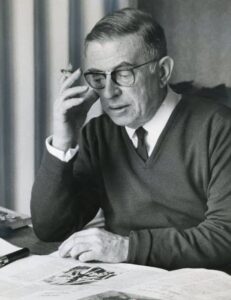INTRODUCTION:
Jean Paul Sartre was a French writer and the most prominent philosopher of 20th century he was the founder in the existentialist movement and in his writings of the work of art he is emphatically reiterating towards the point that the Holistic general and Wholesale view of art is not the matter of concern for this particular exposition which has been espoused by him.
He is more interested in the specific existentialist type of art in the existential aesthetics Sartre, is not concerned with attempting to answer the question that what is beautiful but rather his attempt may be considered to answer the question such as what kind of art is worth making or even the question that what is the purpose that art should be concerned with fulfilling? According to this philosopher the role of artist is to create a material analogon that allows people to comprehend the image when they gaze at this analogon there is no objectification or realization of art hair because art for this person is unreal there are no real quality contents in that piece of art which has been developed by the artist.
There is a particular historical concept that is starting from the ideas that have been reflected by Socrates and Plato in which they are trying to assert to the point that this material world is nothing but a copy paste world of the ultimate reality is which constitute the world of ideas that is real permanent in itself and this particular corporal world is a replica of that particular world of Ideas which is Deemed to be as the ultimate reality this particular world is devoid of any Permanence. When we assert to the point that a particular drawing or a painting that has been created by an artist is nothing but the physical representation of the ideas which are present in a person’s mental consciousness and that the painting is the replica of the reality all of these points which have been highlighted by philosophers such as Plato in his philosophical Outlook towards aesthetics, J. P Sartre is standing in negative of these very ideas he is not supporting these particular expositions because for him work of art is not a duplicate of reality but it is altogether a new reality in and of themselves. 
MAIN EXPLANATION:
In his philosophy, “the world of Ideas” is turned into an “analogon” and does not accept the notion of an imaginative world. For Sartre, the picture no longer defects any external world like in the Plato’s world of Idea. Sartre provides a perfect example to substantiate his point he applicants that an actor who is playing “the role of x” is inhabiting an Unreal universe, if this actor has started shopping within a particular scene on the stage then it is not the actor but the character who is crying and if he attempt to find the Tears in the actual practical world then we would be completely disappointed because these tears are acting as a metaphor for the actual tears. He believes that an image is not a thing it is an act and to imagine is not to perceive there is a big differentiation between consciousness perception and imagination for this philosopher.
He believes that no manipulation over the image is possible and it is given all at once we cannot connect mold or divide further just how some psychologists believe that it can be done. This particular philosopher standing against those people who are asserting the opposite of his assertion the truth according to him is never beautiful. Sartre famously exclaimed that:
“Beauty is a value that can only be given to the imaginary and that carries annihilation of the world in its core structure.”
It is down right nonsensical to connect the moral with aesthetics and even implementing or exercising a more aesthetic Outlook towards the circumstances in life is inconsistent because the two words of Art and that of reality must never collide so as to help in the preservation of the work of art.
Sartre explores this story by using another analogy to explain his point and that is from the painting of Charles VIII where Charles is an aesthetic object which is different from the frame and the Canvas because these two things that is the frame and the Canvas are the only real object of the painting and as long as we are concentrating on the frame and the Canvas singularly the aesthetic object that is the painting of Charles will not present itself to our realizing consciousness. It is only after an abrupt sudden as well as a radical change in our consciousness that we focus on this imaginary thing when consciousness becomes imaginative consciousness. However we must make 1 point very clear that there is no transition from imaginary to real what is real are the strokes of the color brush and the crosseness of the Canvas for him what disease are the application of certain real colors on the Canvas but we must understand that these colors are grassed as a part of an Unreal hole of the aesthetic object it is therefore the Unreal relationship of colors and the forms that take on their real meaning however these entities are not possessing and actual real existence of their own this is just a figment of imagination as per this particular philosopher.

It is an Unreal analogue that must be dubbed as an Unreal aesthetic entity manifesting itself through the means of a real Canvas. It is resulting from the Unreal beautiful object which itself is being constituted and apprehended by our imaginative consciousness. The category of irrealness are significantly applied on the fiction poetry as well as drama he is basically talking about certain pieces of art that have seen to escape The Unreal character by their very nature by providing the example of the melody that refers to nothing but itself he takes the instance of an orchestra playing a Symphony and as an audience he must have objection to an amateur orchestra playing this particular Symphony primarily because of the reason that as they would be betraying the work it is trying to play. This is because, they will not be able to do adequate justice to the chords and tones it attempts to play but we must ponder that is the symphony is it real or an Unreal hole we must be site full of the fact that he is listening to the symphony and this particular Idea means that this does not exist in a specific space time frame one does not grasp it as a particular historical incident primarily because this has not been segregated marked in points of dates as it has been played and replayed inconsistently again and again they are after by expanding is question by adding that how does one Seas the symphony this has been efficiently answer by asserting to the point that it is either by Shirting the eyes or by seeing the orchestra but one point which is very clear is that they are actually not seeing the thing they are looking towards they are trying to feel they are trying to send they are trying to hear that particular feeling but can’t see that particular thing (i.e. the Beethoven’s Seventh Symphony)
CRITICAL ANALYSIS:
It must be carefully noted that he mentions that this aesthetic enjoyment is real; it is not grasped for itself as if produced by a real color; it is a better manner of apprehending the Unreal object and far from being directed on a real painting it serves to constitute the imaginary object through the real Canvas. He believes that this comfort once experienced by the viewer is nothing but that of a dreamer on awakening and entranced consciousness engulfed in imaginary seclusions suddenly liberated from the dynamic end of the play or the same funny and comes suddenly in contact with the existence as well as the significant surroundings of a man. This all brings just to the same point that why the Portrait of Charles is necessarily year correlative of an imaginative consciousness he is disagreeing that the painting is realization of images in the mind of a painter that are becoming reality but they are as a matter of act completely and wholly irreal. 
We have morals virtues and Standards that evaluate our behavior to be close to or deviant from being appropriated by the ethics all of these categories do not need any aesthetic Outlook simply because of the fact that life can do well without these contemplations and that they are unreal in whole sense because it could only lead to steps of nothing else and even believing in something of this likeness, means the basic absurdity of existence he has in short denied the reality of events and objects as well as acts that are being presented through the poem painting or photograph this forms the critical basis which is significant for drawing the necessary conclusion for the art related explanation provided by Sartre.
CONCLUSION:
“It is not the character who becomes real in the actor, it is the actor who becomes Unreal in his character”
it could roughly indicate that the artwork is Unreal and they are not claiming to come out of imagination to Reality the artwork the world of imaginations are nothing but Unreal. The Beauty aspect can never be applied to the things that are actually existing in this world but on the other hand he believes that there is an aspect of poverty in the images or photographs. This word poverty could be interpreted as that entity which does not have any subsistence and because of this reason the imaginative object remains ambiguous. There are no precepts of divinity godliness or something that is of supernatural essence which could be closely associated to the work of art that has been created by any artist they are neither the part or replicas or copy paste entities of the world of Ideas as has been significantly embarked by various elder philosophers of Greek epistemology.




























